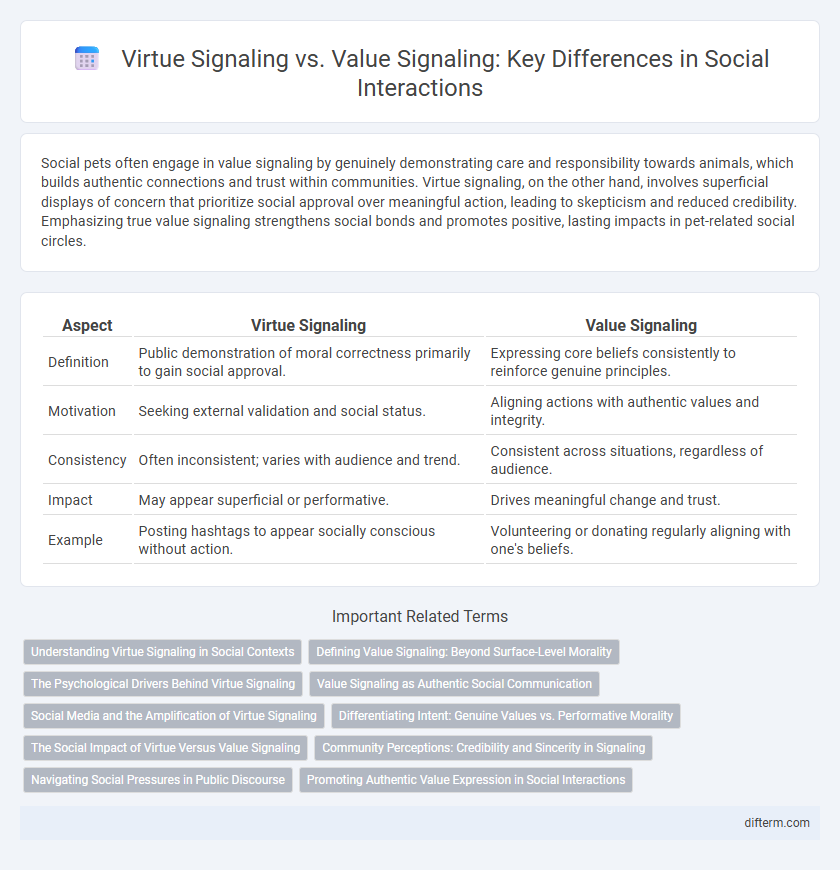Social pets often engage in value signaling by genuinely demonstrating care and responsibility towards animals, which builds authentic connections and trust within communities. Virtue signaling, on the other hand, involves superficial displays of concern that prioritize social approval over meaningful action, leading to skepticism and reduced credibility. Emphasizing true value signaling strengthens social bonds and promotes positive, lasting impacts in pet-related social circles.
Table of Comparison
| Aspect | Virtue Signaling | Value Signaling |
|---|---|---|
| Definition | Public demonstration of moral correctness primarily to gain social approval. | Expressing core beliefs consistently to reinforce genuine principles. |
| Motivation | Seeking external validation and social status. | Aligning actions with authentic values and integrity. |
| Consistency | Often inconsistent; varies with audience and trend. | Consistent across situations, regardless of audience. |
| Impact | May appear superficial or performative. | Drives meaningful change and trust. |
| Example | Posting hashtags to appear socially conscious without action. | Volunteering or donating regularly aligning with one's beliefs. |
Understanding Virtue Signaling in Social Contexts
Virtue signaling involves publicly expressing opinions or sentiments to demonstrate moral superiority within social groups, often without meaningful action. In contrast, value signaling communicates core beliefs and commitments authentically, aiming to build genuine connections and influence social behavior. Recognizing the difference enhances social dynamics by promoting sincerity over performative gestures in digital and offline interactions.
Defining Value Signaling: Beyond Surface-Level Morality
Value signaling goes beyond virtue signaling by emphasizing authentic expressions of core beliefs and principles rather than performative morality. It reflects consistent actions and decisions aligned with deeply held values, creating meaningful social impact instead of seeking mere approval. This form of signaling prioritizes integrity and long-term commitment over fleeting social validation.
The Psychological Drivers Behind Virtue Signaling
Virtue signaling is driven by psychological desires for social approval and identity affirmation, where individuals publicly display moral values to gain acceptance and status. This behavior often stems from a need to align with group norms and reinforce self-concept, even if the actions lack substantive impact. In contrast, value signaling prioritizes authentic commitment to causes, emphasizing consistent behavior that reflects deeply held beliefs rather than mere social performance.
Value Signaling as Authentic Social Communication
Value signaling represents authentic social communication by genuinely expressing core beliefs and principles rather than superficial or performative gestures. Unlike virtue signaling, which often aims to garner approval or social status, value signaling fosters trust and meaningful connections by aligning actions with deeply held values. This honest expression strengthens community bonds and promotes integrity within social interactions.
Social Media and the Amplification of Virtue Signaling
Social media platforms amplify virtue signaling by enabling users to publicly display moral stances with minimal effort, often prioritizing social approval over genuine commitment to values. Unlike value signaling, which reflects authentic expression of core beliefs, virtue signaling frequently manifests as performative gestures aimed at enhancing social status or group belonging. This dynamic fosters superficial interactions that can dilute meaningful discourse and obscure true advocacy within online communities.
Differentiating Intent: Genuine Values vs. Performative Morality
Virtue signaling often prioritizes public approval by showcasing moral stances without deep personal commitment, while value signaling reflects authentic beliefs driving consistent actions. The key difference lies in intent: virtue signaling seeks external validation, whereas value signaling emerges from internal principles guiding behavior. Understanding this distinction helps identify when social expressions of ethics are performative versus genuinely rooted in individual or collective values.
The Social Impact of Virtue Versus Value Signaling
Virtue signaling often triggers social division by highlighting moral superiority without fostering genuine understanding or cooperation, whereas value signaling promotes authentic engagement by emphasizing shared principles and long-term commitments. Research shows communities embracing value signaling experience higher trust levels and collective action, driving meaningful social change. Empirical studies indicate that value signaling reduces performative behaviors, encouraging inclusive dialogue and sustained impact within societal networks.
Community Perceptions: Credibility and Sincerity in Signaling
Virtue signaling often attracts skepticism in community perceptions due to its association with performative acts lacking genuine commitment, which can undermine credibility. Value signaling, by contrast, emphasizes consistent actions aligned with deeply held beliefs, fostering sincere trust and stronger social cohesion. Communities tend to reward authentic value signaling with increased respect and long-term support, distinguishing it from superficial virtue displays.
Navigating Social Pressures in Public Discourse
Virtue signaling often manifests as performative expressions aimed at garnering social approval without substantive action, whereas value signaling reflects genuine commitment to principles through consistent behavior and advocacy. Navigating social pressures in public discourse requires discerning authentic engagement from superficial displays, emphasizing meaningful contributions over image management. Understanding these dynamics empowers individuals to foster integrity and constructive dialogue within community and online platforms.
Promoting Authentic Value Expression in Social Interactions
Promoting authentic value expression in social interactions fosters genuine connections and discourages performative behavior often seen in virtue signaling. Emphasizing consistent actions aligned with core beliefs enhances trust and encourages meaningful dialogue within communities. Distinguishing between superficial displays and sincere value-driven communication cultivates deeper social bonds and strengthens collective integrity.
virtue signaling vs value signaling Infographic

 difterm.com
difterm.com